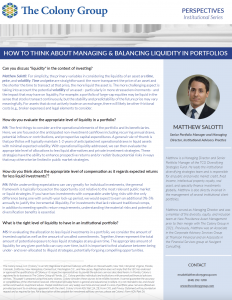How to Think About Managing & Balancing Liquidity in Portfolios
Can you discuss “liquidity” in the context of investing?
For simplicity, the primary variables in considering the liquidity of an asset are time, price, and volatility. Time and price are straightforward: the more transparent the price of an asset and the shorter the time to transact at that price, the more liquid the asset is. The more challenging aspect is taking into account the potential volatility of an asset, particularly in more stressed environments, and the impact that may have on liquidity. For example: a portfolio of large-cap equities may be liquid in the sense that stocks transact continuously, but the stability and predictability of the future price may vary meaningfully. For assets that do not actively trade on an exchange, there will likely be other frictional costs (e.g., broker expenses) and legal elements to consider.
How do you evaluate the appropriate level of liquidity in a portfolio?
The first things to consider are the operational elements of the portfolio and its beneficiaries. Here, we are focused on the anticipated non-investment cashflows including recurring annual draws, potential inflows or contributions, and prospective capital expenditures. A general rule-of-thumb is that portfolios will typically maintain 1-2 years of anticipated net operational draws in liquid assets with minimal expected volatility. With operational liquidity addressed, we can then evaluate the appropriate level of allocations to less liquid alternatives and private investment strategies. These strategies have the ability to enhance prospective returns and/or redistribute potential risks in ways that may otherwise be limited in public market strategies.
How do you think about the appropriate level of compensation as it regards expected returns for less liquid investments?
While underwriting expectations can vary greatly for individual investments, the general framework is typically focused on the opportunity cost relative to the most relevant public market or liquid strategies. If you have two investments with comparable underlying risks with the only difference being one with a multi-year lock-up period, we would expect to earn an additional 3%-5% annually to justify the incremental illiquidity. For investments that lack relevant traditional comps, in addition to meeting specific return requirements, understanding the material risks and potential diversification benefits is essential.
What is the right level of liquidity to have in an institutional portfolio?
In evaluating the allocation to less liquid investments in a portfolio, we consider the amount of invested capital as well as the amount of uncalled commitments. Together, these represent the total amount of potential exposure to less liquid strategies at any given time. The appropriate amount of liquidity for any given portfolio can vary over time, but it is important to find a balance between being under- and over-allocated to illiquid strategies, potentially forgoing compelling opportunities.


